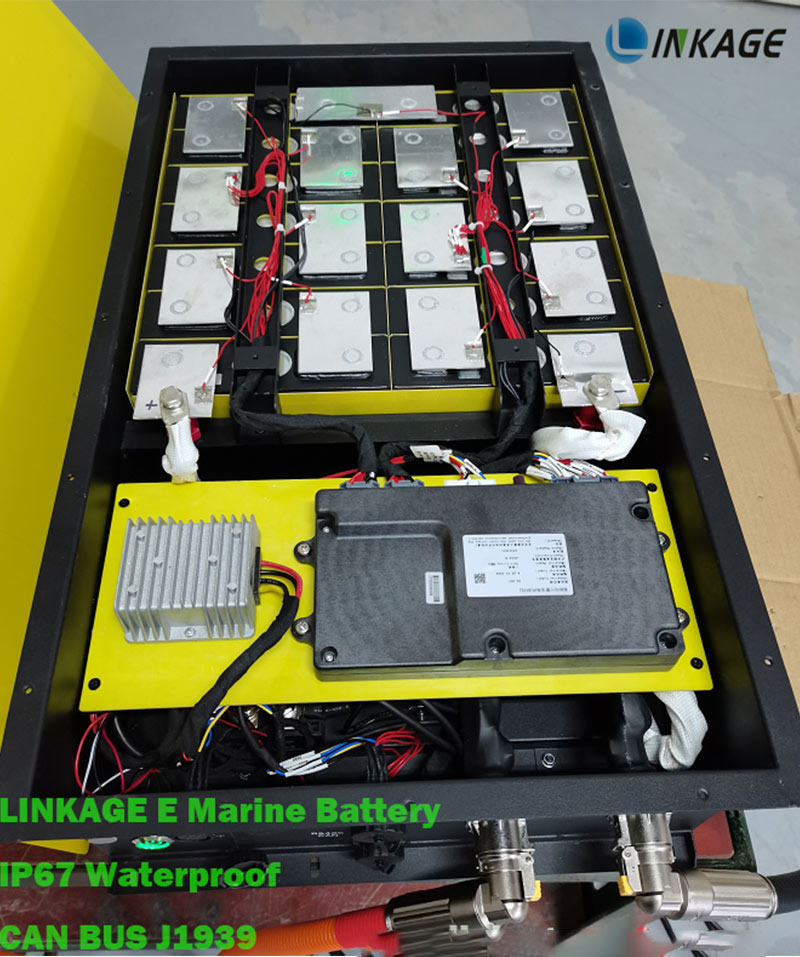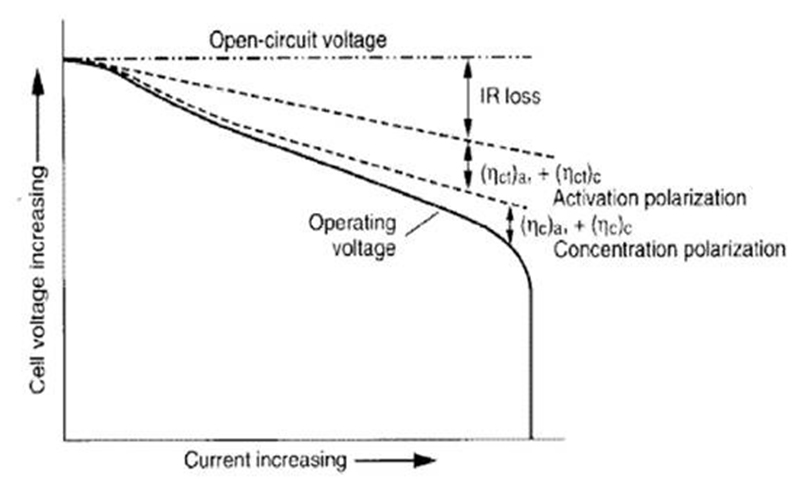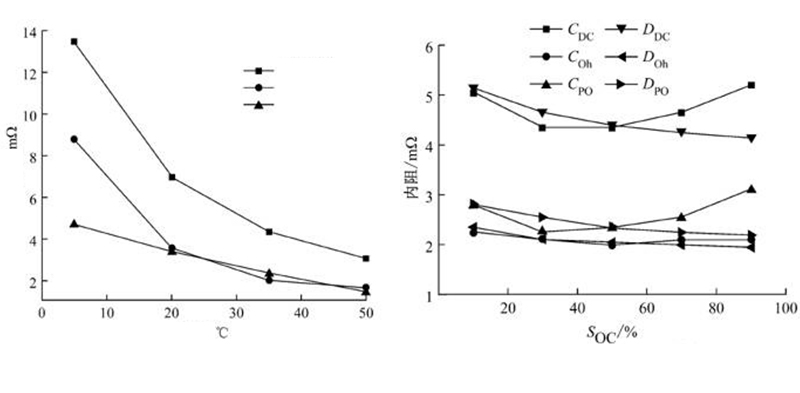

The internal resistance is the resistance of the lithium battery when the current flows through the battery. According to the test method, it can be divided into AC internal resistance and DC internal resistance. The internal resistance of the battery is an important parameter to identify the quality of lithium-ion batteries. The large internal resistance of the battery will generate a large amount of Joule heat and cause the temperature of the battery to rise. Cause serious impact. In the test to verify the electrochemical performance of lithium batteries by various factors, internal resistance is also an important parameter for investigation. Combine the materials and processes of lithium batteries to share with you the factors affecting the internal resistance of lithium batteries.
Generally, battery internal resistance is divided into ohmic internal resistance and polarization internal resistance. The ohmic internal resistance is composed of electrode material, electrolyte, diaphragm resistance and the contact resistance of each part. Polarization internal resistance refers to the resistance caused by polarization during electrochemical reaction, including electrochemical polarization internal resistance and concentration polarization internal resistance. The ohmic internal resistance of the battery is determined by the total conductivity of the battery, and the polarization internal resistance of the battery is determined by the solid phase diffusion coefficient of lithium ions in the electrode active material.

The ohmic resistance is mainly divided into three parts, one is ionic impedance, the other is electronic impedance, and the third is contact impedance. We hope that the internal resistance of the lithium battery is as small as possible, so we need to take specific measures to reduce the ohmic internal resistance for these three items.
1. Ion impedance
Lithium battery ion resistance refers to the resistance to the transmission of lithium ions inside the battery. In a lithium battery, the lithium ion migration speed and the electron conduction speed play an equally important role, and the ion resistance is mainly affected by the positive and negative electrode materials, the separator, and the electrolyte. To reduce ion impedance, you need to do the following:
①Ensure that the positive and negative materials and electrolyte have good wettability.
It is necessary to select a suitable compaction density when designing the pole piece. If the compaction density is too large, the electrolyte is not easy to infiltrate, which will increase the ion resistance. For the negative pole piece, if the SEI film formed on the surface of the active material during the first charge and discharge is too thick, it will also increase the ion resistance. At this time, it is necessary to adjust the formation process of the battery to solve it.
②The influence of electrolyte
The electrolyte must have the appropriate concentration, viscosity and conductivity. When the viscosity of the electrolyte is too high, it is not conducive to the infiltration between the electrolyte and the active materials of the positive and negative electrodes. At the same time, the electrolyte also needs a low concentration, too high concentration is also not conducive to its flow and infiltration. The conductivity of the electrolyte is the most important factor affecting ion resistance, which determines the migration of ions.
③The influence of diaphragm on ion impedance
The main influencing factors of the diaphragm on the ion resistance are: electrolyte distribution in the diaphragm, diaphragm area, thickness, pore size, porosity, and tortuosity coefficient. For ceramic diaphragms, it is also necessary to prevent ceramic particles from blocking the pores of the diaphragm, which is not conducive to the passage of ions. While ensuring that the electrolyte is fully infiltrated into the diaphragm, there should be no excess electrolyte remaining in it, which reduces the efficiency of the electrolyte.
2. Electronic impedance
There are many influencing factors of electronic impedance, which can be improved from aspects such as materials and processes.
①Positive and negative pole plates
The main factors that affect the electronic impedance of the positive and negative plates are: the contact between the active material and the current collector, the factors of the active material itself, and the parameters of the plate. The active material should be in full contact with the current collector surface, which can be considered from the current collector copper foil, aluminum foil base material, and the adhesion of the positive and negative electrode pastes. The porosity of the living material itself, the by-products on the surface of the particles, and the uneven mixing with the conductive agent, etc., will cause the electronic impedance to change. Polar plate parameters such as the density of living matter is too small, the gap between the particles is too large, which is not conducive to electron conduction.
② Diaphragm
The main influencing factors of the diaphragm on the electronic impedance are: the thickness of the diaphragm, the porosity and the by-products in the charge and discharge process. The first two are easy to understand. After the battery is disassembled, a thick layer of brown material is often found on the separator, including the graphite negative electrode and its reaction byproducts, which will block the diaphragm pores and reduce the battery life.
③ Current collector base material
The material, thickness, width of the current collector and the degree of contact with the tabs all affect the electronic impedance. The current collector needs to choose a substrate that has not been oxidized and passivated, otherwise it will affect the impedance. Poor welding between copper and aluminum foil and tabs will also affect electronic impedance.
3. Contact resistance
Contact resistance is formed between the contact between the copper and aluminum foil and the active material, and the adhesiveness of the positive and negative electrode pastes needs to be paid attention to.
2. Polarized internal resistance
When current passes through the electrodes, the phenomenon that the electrode potential deviates from the equilibrium electrode potential is called electrode polarization. Polarization includes ohmic polarization, electrochemical polarization and concentration polarization, as shown in Figure 1. Polarization resistance refers to the internal resistance caused by the polarization of the positive electrode and the negative electrode of the battery during the electrochemical reaction. It can reflect the internal consistency of the battery, but it is not suitable for production due to the influence of the operation and method. The internal polarization resistance is not constant, and it changes with time during the charging and discharging process. This is because the composition of the active material, the concentration and temperature of the electrolyte are constantly changing. The ohmic internal resistance obeys Ohm’s law, and the polarization internal resistance increases with the increase of the current density, but it is not a linear relationship. It often increases linearly as the logarithm of the current density increases.

OCV-working voltage-polarization voltage relationship diagram
Generally speaking, the DC internal resistance of the battery is equal to the sum of the polarization internal resistance and the ohmic internal resistance. The measurement of DC internal resistance is of great significance. There are many factors that affect the internal resistance of polarization, such as charge and discharge rate, ambient temperature, SOC state, electrolyte concentration and so on. Here is an example of temperature influence on the internal resistance of lithium iron phosphate batteries. Those who need relevant literature can privately write to the editor, as shown in the figure below:

Third, the battery internal resistance measurement method currently used in the industry
In industry applications, the accurate measurement of battery internal resistance is carried out by special equipment. At present, the battery internal resistance measurement methods used in the industry mainly include the following two:
1. DC discharge internal resistance measurement method
According to the physical formula R=U/I, the test equipment forces the battery to pass a large constant DC current in a short period of time (usually 2 to 3 seconds) (currently a large current of 40A to 80A is generally used), and the battery is measured at this time The voltage at both ends and the current internal resistance of the battery are calculated according to the formula.
The accuracy of this measurement method is relatively high. With proper control, the measurement accuracy error can be controlled within 0.1%. But this method has obvious shortcomings:
(1) It can only measure large-capacity batteries or accumulators, and small-capacity batteries cannot load a large current of 40A-80A within 2 to 3 seconds;
(2) When the battery passes a large current, the electrodes inside the battery will be polarized, resulting in polarized internal resistance. Therefore, the measurement time must be very short, otherwise the measured internal resistance value will have a large error;
(3) The large current flowing through the battery will damage the internal electrodes of the battery to a certain extent.
2. AC pressure drop internal resistance measurement method
Because the battery is actually equivalent to an active resistance, we apply a fixed frequency and a fixed current to the battery (currently 1kHz frequency and 50mA small current are generally used), and then sample its voltage, and go through a series of processing such as rectification and filtering. Then calculate the internal resistance of the battery through the operational amplifier circuit. The battery measurement time of the AC voltage drop internal resistance measurement method is extremely short, generally about 100 milliseconds.
The accuracy of this measurement method is also good, and the measurement accuracy error is generally between 1% and 2%.
The advantages and disadvantages of this method:
(1) Almost all batteries can be measured using the AC voltage drop internal resistance measurement method, including small-capacity batteries. This method is generally used to measure the internal resistance of laptop battery cells.
(2) The measurement accuracy of the AC voltage drop measurement method is likely to be affected by the ripple current, and there is also the possibility of harmonic current interference. This is a test for the anti-interference ability in the measuring instrument circuit
(3) This method will not cause much damage to the battery itself.
(4) The measurement accuracy of the AC voltage drop measurement method is not as good as that of the DC discharge internal resistance measurement method.